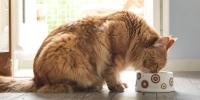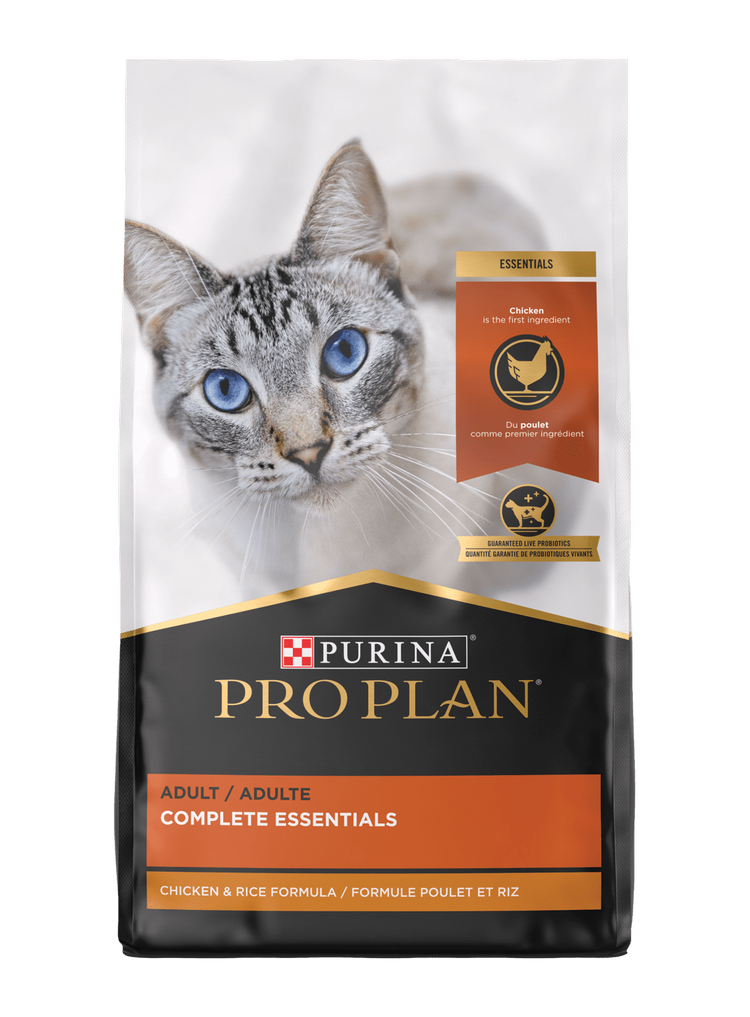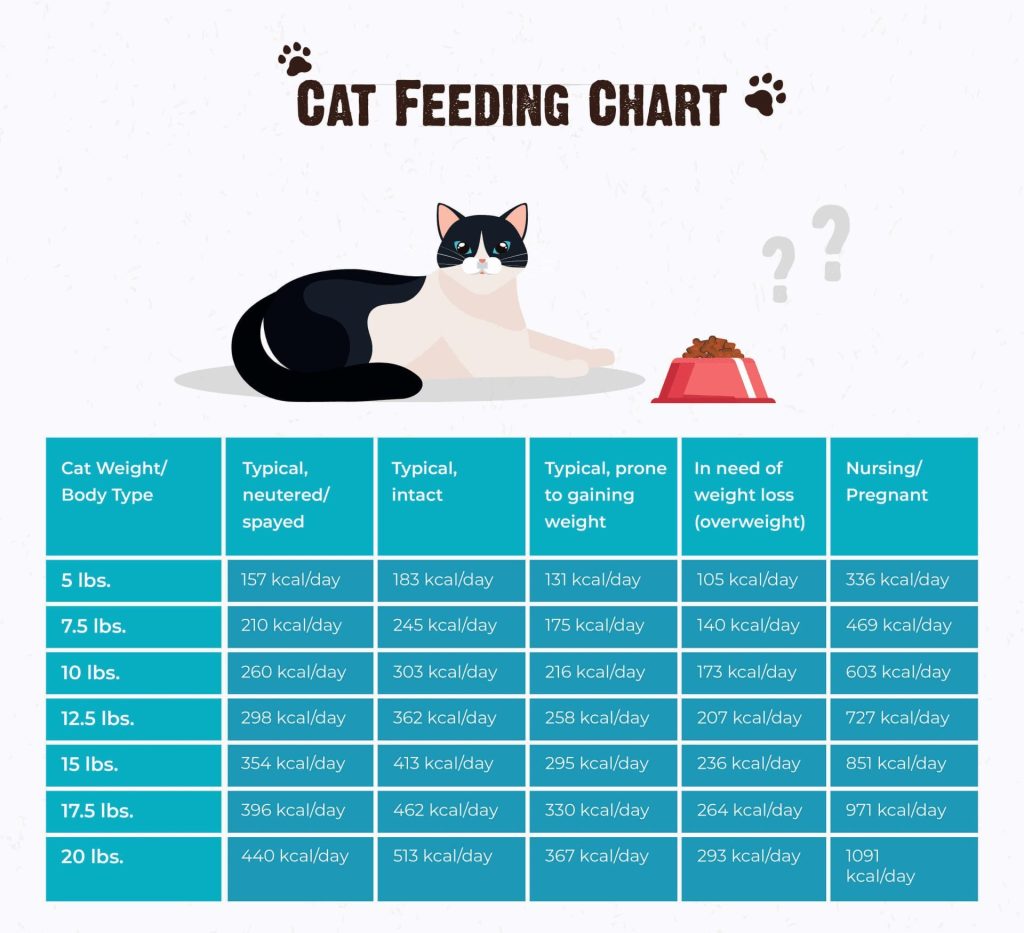Are you unsure about how much food your cat really needs each day? Feeding your cat the right amount is key to keeping them happy and healthy.
Too much food can lead to weight gain, while too little can leave your furry friend hungry and lacking energy. You’ll discover simple guidelines to help you find the perfect feeding portion for your cat. Keep reading, and you’ll learn how to make mealtime stress-free and enjoyable for both you and your cat.

Credit: www.dogfood.com.my
Daily Calorie Needs
Understanding your cat’s daily calorie needs is essential to keep them healthy and energetic. Just like people, cats require the right amount of calories to maintain their body weight and support their daily activities. Feeding too much or too little can lead to health problems, so knowing the right balance is key.
Factors Influencing Calorie Requirements
Not all cats need the same number of calories. Several factors affect how many calories your cat should eat each day. Age, weight, breed, and overall health all play a role.
For example, a larger breed like a Maine Coon naturally needs more calories than a smaller cat like a Siamese. Health issues such as thyroid problems or diabetes can also change calorie needs dramatically. Even the environment matters—indoor cats usually burn fewer calories than outdoor cats.
Calories For Different Life Stages
Your cat’s calorie needs change as they grow. Kittens need more calories per pound to support their rapid growth and high energy levels. They can require nearly twice the calories of an adult cat.
Adult cats maintain their weight with a steady calorie intake, but seniors often need fewer calories due to decreased activity and slower metabolism. Adjusting food amounts as your cat ages helps prevent obesity or malnutrition.
Adjusting For Activity Levels
Activity level is a huge factor in how many calories your cat needs. A playful, active cat will burn more energy and need more food to stay satisfied. On the other hand, a calm or older cat that spends most of its day resting requires fewer calories.
Think about your cat’s daily routine. Do they chase toys, climb, and explore, or do they prefer lounging in sunny spots? Adjust their food portions accordingly to avoid overfeeding or hunger. Have you noticed your cat’s energy changing? It might be time to rethink their calorie intake.
Portion Sizes By Cat Type
Feeding your cat the right portion size is key to their health. Different cat types need different amounts of food daily. Age, activity level, and body condition all matter.
Understanding portion sizes by cat type helps prevent overfeeding or underfeeding. It supports healthy growth and maintains an ideal weight. Let’s explore how much food to give your kitten, adult, senior, and overweight cat.
Kittens
Kittens need more food than adult cats. Their bodies grow fast and use a lot of energy. Feed small meals often throughout the day.
- Offer about 3 to 4 meals daily.
- Feed wet or dry food formulated for kittens.
- Portion: ¼ to ½ cup per meal depending on kitten size.
Monitor their weight weekly. Adjust portions as they grow.
Adult Cats
Adult cats require balanced portions to maintain weight. Their metabolism slows compared to kittens.
- Feed 2 meals per day.
- Portion: Usually ½ cup of dry food or equivalent wet food per meal.
- Check body condition monthly to adjust amounts.
Senior Cats
Senior cats may need fewer calories. Their activity often decreases with age.
- Feed 2 smaller meals daily.
- Portion: Slightly less than adult cats, about ¼ to ⅓ cup per meal.
- Choose food made for senior cats to support health.
Watch for weight loss or gain and adjust feeding as needed.
Overweight Cats
Overweight cats need controlled portions to lose weight safely. Avoid free-feeding.
- Feed measured meals twice a day.
- Portion: Reduce by 20-30% from their usual intake.
- Use weight management cat food if possible.
Regularly weigh your cat and consult a vet for guidance.
Wet Food Vs Dry Food
Choosing between wet food and dry food for your cat affects how much you should feed daily. Both types offer unique benefits and challenges. Understanding these can help you provide the right amount of food to keep your cat healthy and happy.
Calorie Density Differences
Wet food contains more water, so it has fewer calories per gram. Dry food is more calorie-dense because it has less moisture. This means cats eat less volume of dry food to get the same calories. Pay attention to calorie counts on the packaging. Feeding the right calories is key to avoid overfeeding or underfeeding.
Hydration Considerations
Wet food helps keep cats hydrated due to its high water content. Cats that eat dry food need extra water from a bowl or fountain. Proper hydration supports kidney health and digestion. Cats often drink less water on dry food diets, so monitor their water intake closely.
Mixing Food Types
Feeding a mix of wet and dry food can balance benefits. Wet food adds moisture and variety. Dry food supports dental health by reducing plaque. Mixing foods requires adjusting portions to avoid extra calories. Keep track of how much your cat eats daily from each type.

Credit: www.purina.com
Feeding Frequency
Feeding frequency plays a big role in your cat’s health and happiness. Cats have different needs at various life stages. Offering food at the right times helps maintain energy and digestion. It also prevents overeating or hunger. Understanding the best feeding schedule supports your cat’s well-being.
Meal Times For Kittens
Kittens grow fast and need more meals daily. They usually eat four small meals a day. This helps keep their energy steady. Smaller, frequent meals support their rapid growth and high energy. Try feeding at these times:
- Early morning
- Midday
- Late afternoon
- Evening
Keep portions small and balanced. Avoid skipping meals to prevent low blood sugar.
Meal Times For Adults
Adult cats do well with fewer meals. Most thrive on two meals daily. This schedule fits their slower metabolism. Feed once in the morning and once in the evening. Consistent meal times help regulate their appetite. This also reduces begging or overeating.
Portion sizes depend on your cat’s weight and activity. Adjust amount to maintain a healthy body condition.
Free Feeding Pros And Cons
Free feeding means leaving food out all day. Cats can eat anytime they want. This suits some cats but not all. Here are benefits and drawbacks:
| Pros | Cons |
|---|---|
| Convenient for busy owners | May cause overeating |
| Good for cats that graze | Hard to monitor food intake |
| Reduces stress for some cats | Food can spoil if left too long |
Choose feeding style based on your cat’s habits and health. Regular meals often help control weight better.
Signs Of Overfeeding And Underfeeding
Feeding your cat the right amount of food is crucial for its health. Overfeeding and underfeeding show clear signs. Recognizing these signs helps keep your cat happy and healthy. Watch closely for changes in weight, behavior, and health.
Weight Changes
Weight is the easiest sign to spot. Overfed cats gain weight quickly. Their bellies look rounder and heavier. Underfed cats lose weight and appear thin. You may see ribs or spine more clearly. Sudden weight changes need attention.
Behavioral Indicators
Behavior shifts when cats are not fed properly. Overfed cats may seem lazy or less active. They might sleep more and show less interest in play. Underfed cats act restless and hungry. They may meow loudly or beg for food often. Watch your cat’s energy and mood closely.
Health Risks
Both overfeeding and underfeeding cause health problems. Overfeeding leads to obesity, diabetes, and joint stress. Underfeeding causes weak immune systems and muscle loss. Long-term poor feeding can shorten your cat’s life. Regular vet visits help catch these risks early.
Tips For Portion Control
Controlling your cat’s food portions helps keep them healthy and active. Overfeeding can lead to weight problems and other health issues. Feeding the right amount supports their energy and wellbeing. Use these tips to serve the perfect portions every day.
Measuring Food Accurately
Use a kitchen scale or measuring cup to weigh your cat’s food. Avoid guessing the amount by eye. Check the feeding guide on the food package for daily portions. Measure dry and wet food separately for best results. Accurate portions prevent overfeeding and waste.
Using Feeding Tools
Automatic feeders control meal sizes and times. These tools help manage portions without stress. Use bowls designed to slow down eating if your cat eats too fast. Portion control feeders keep your cat from eating too much at once. These tools make feeding easier and cleaner.
Creating A Feeding Schedule
Feed your cat at the same times every day. Small, frequent meals work better than one large meal. A schedule helps control hunger and prevents overeating. Consistent feeding times support your cat’s digestion and energy levels. Stick to the routine for steady portion control.
When To Consult A Veterinarian
Knowing how much to feed your cat daily can be tricky. Sometimes, your cat’s needs change. Certain signs suggest it’s time to ask a veterinarian for advice. A vet’s guidance helps keep your cat healthy and happy.
Special Dietary Needs
Some cats need special diets due to age or breed. Kittens and senior cats require different nutrition. A vet can recommend the right food type and amount. Cats with allergies or sensitivities also need tailored diets. Professional advice ensures they get the right nutrients.
Health Conditions
Illnesses affect your cat’s appetite and digestion. Conditions like kidney disease or diabetes require specific feeding plans. Vets adjust food quantity and quality for these cases. Feeding your cat the wrong amount can worsen health problems. Regular vet visits help monitor and manage these issues.
Weight Management Plans
Overweight or underweight cats need careful feeding control. A vet can create a weight loss or gain plan. They set daily food portions based on your cat’s condition. Tracking progress with a vet avoids feeding errors. Proper guidance supports your cat’s long-term health.

Credit: www.purina.com
Frequently Asked Questions
How Much Food Does An Average Cat Need Daily?
An average adult cat typically needs 200-300 calories daily. This equals about 1/3 to 1/2 cup of dry food or 5. 5 ounces of wet food. Adjust portions based on your cat’s age, weight, and activity level for optimal health.
Should Feeding Amounts Vary By Cat’s Age?
Yes, kittens require more calories for growth, while senior cats need fewer. Feeding guidelines vary by life stage to support energy needs and metabolism. Consult your vet for age-specific feeding recommendations to maintain your cat’s ideal weight.
Can I Feed My Cat Twice A Day?
Feeding cats twice daily is common and helps regulate metabolism. Split the daily food amount into two meals for better digestion and weight control. Consistency in feeding times supports your cat’s routine and prevents overeating.
How Do I Adjust Food For An Overweight Cat?
Reduce daily calorie intake gradually and increase exercise. Consult your vet for a tailored weight loss plan. Feeding measured portions and avoiding treats helps prevent further weight gain and promotes healthy weight loss.
Conclusion
Finding the right food amount keeps your cat healthy. Pay attention to their weight and energy. Adjust portions as needed. Always provide fresh water. Consult a vet for specific advice. Every cat is unique. Regular check-ups help ensure their diet suits them.
Your cat’s happiness depends on balanced nutrition. Keep observing their behavior and appetite. Proper feeding leads to a happier, healthier cat. Make mealtime enjoyable. They’ll thank you with purrs and love.

